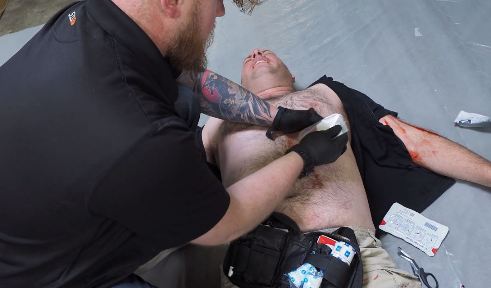What If You Don’t Have a Tourniquet or Trauma Kit? Bleeding: Part 2

This article will focus on what other steps can be taken to reduce blood loss when you are caught in a bad situation without gear. Now that we understand how to apply direct pressure and why it’s probably better then trying to make a tourniquet, we can look at methods for increasing our effectiveness.
This week will continue along with the theme of how to save a life without medical gear.
Wound Packing
If you have our Yellowstone Trauma Kit you’ll feel comforted to know it contains a roll of QuikClot, a hemostatic agent (makes blood clot quicker).
This is a handy item to have in a pinch, but if you don’t have any, what else can be done?
Research shows packing wounds with gauze, any gauze, is an effective way to control bleeding. All you need to do is make some.
Find the cleanest cloth available. If you have some scissors, you can cut strips from the shirt off the casualty to improvise your own gauze. Avoid using a knife if the clothing is still on the casualty because of the danger of cutting and further injuring the victim.
If you don't have any cutting tools, find a way to make a hole in the shirt with something like a pencil. This gives you a place to start a tear for ripping strips of cloth.
Use the gauze like you would when packing the wound with QuikClot:
- Roll the end of the gauze into a ball or tie a small knot in the end.
- Pack the ball down as close to, or on top of, the bleeding artery as possible.
- Continue to pack as much gauze into the wound as you can get in. This will help ensure maximum pressure is applied over the bleed source.
- Pile the remaining gauze on top of the wound and continue to apply direct pressure. If QuikClot was used, the amount of time recommended for direct pressure is at least 3 minutes. I recommend longer if possible.
Since there are probably no hemostatic agents in the victim’s shirt, you must hold direct pressure for a minimum of 10 minutes to ensure a clot has formed to adequately control bleeding.
Ideally, you would continue to maintain pressure on the wound, where you can keep it under constant observation, until EMS or Law Enforcement arrives with a professional tourniquet.
